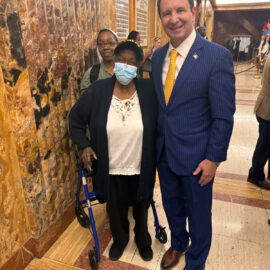
The Governor ants to use the infrastructure funds to combat greenhouse gases. Bring on the electric vehicles!
Gov. John Bel Edwards wants to use federal infrastructure funds to add electric vehicles to parish transit systems, build electric vehicle charging stations in various parishes, and to plug abandoned oil and gas wells across the state, he said this week. The changes are meant to curb Louisiana’s greenhouse gas emissions, and they align with a multi-year climate action plan a state task force approved earlier this year. During a Wednesday meeting with members of that Climate Initiatives Task Force, Edwards said funds from the $1.2 trillion federal Infrastructure Investment and Jobs Act should be able to jumpstart Louisiana’s switch from an oil-and-gas dominant economy to one that doesn’t rely on carbon-generating fuels. Though the states must apply for those funds – and the process is competitive – the Biden administration has said it will give preference to projects that are aimed at mitigating climate change’s effects, Edwards told the task force. “This is a rare opportunity to invest in our state, but also make good on the commitments in the Climate Action Plan,” the governor said. “By 2035, we should produce 5 gigawatts of energy from offshore wind; transition 50% of our public fleets to low and zero emission vehicles and fuels; and double alternative modes of transportation.”
nola.com
There is money coming in to do some of this as well as some specific projects.
During the meeting, Jackson Wright, the state’s new infrastructure implementation coordinator, pointed to the amount of money available nationwide for different climate-related categories of the law: $28 billlion for clean energy transition, including wind and solar generating facilities, $68 billion for industrial decarbonization, including manufacturing low or zero-carbon hydrogen; development of carbon capture processes, including underground permanent storage; building pipelines necessary to move carbon dioxide to such facilities; carbon-reduction processes for industrial facilities; and methods for removing carbon directly from the air, $5 billion for actively managed methane emissions, including from operating or abandoned oil and gas wells, $569 billion for transportation, development and the built environment, including adding electric vehicles to public transit systems, and making homes and businesses more energy efficient, $22 billion for natural and working lands and wetlands, including investing in conservation of wetlands, agriculture and forestry areas as long-term carbon sinks, $4 billion for tribal resilience and $422 million to support an “inclusive, low-carbon economy,” including job training aimed at supporting no-carbon and low-carbon industry, and an emphasis on “Made in America” investments.
It has been said that we are in the front of climate change effects and the Governor realizes it though the legislature does not.
“Our state is more impacted by climate change than any other state in the country,” Edwards said. “Both from sea level rise and storms, their increasing frequency and severity, you all know that. But also, on the other side of that, we are doing more than any other state in terms of climate change adaptation.” The governor said it’s important that the state address carbon reduction measures in every segment of its economy, despite some pushback the task force’s final plan received from some of its industry representatives. And even though the state is still considered a carbon-based energy and oil and gas economy, carbon-fueled energy already is on the wane in Louisiana, he said, even in light of new efforts to increase oil and gas production as a result of the disruption of world markets by the Russian war against Ukraine. “This transition is underway. And quite frankly, its going to be driven more by the private sector than the public sector, and that is already happening,” Edwards said. As if to underscore that point, a representative from the federal Bureau of Ocean and Energy Management told task force members after Edwards’ presentation that the agency plans to decide by 2023 which companies will be allowed to lease portions of the Gulf of Mexico to build wind farms.
The Governor has a good idea and hopefully we will begin doing what we need to do.



